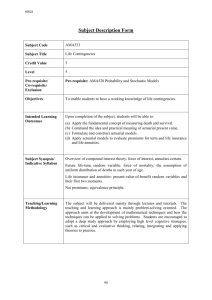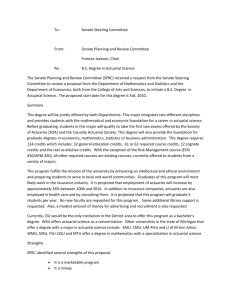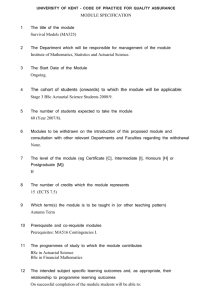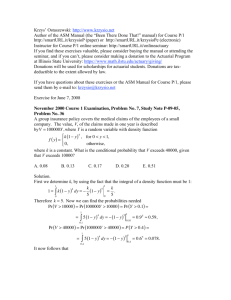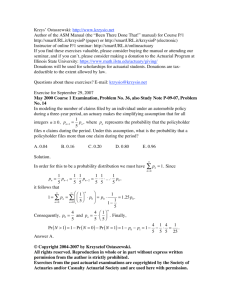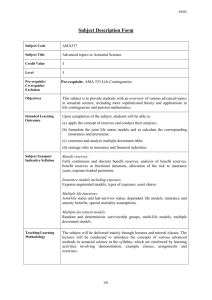Updating the Berquist Sherman Paper—Thirty Years Later
advertisement
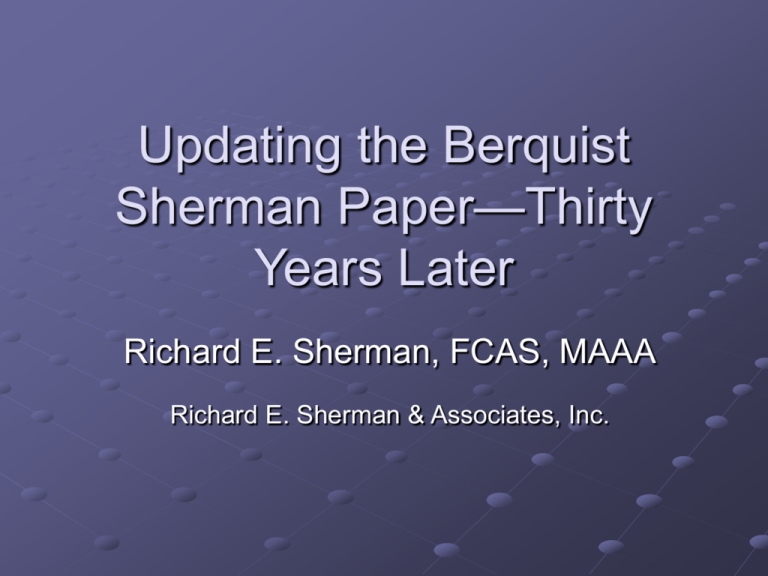
Updating the Berquist Sherman Paper—Thirty Years Later Richard E. Sherman, FCAS, MAAA Richard E. Sherman & Associates, Inc. Most Useful Parts of the Paper Favorite choice is Appendix B, the questions to ask department executives. Second are the claims disposed adjustments and the adjustments to incurred triangles for changes in the adequacy level of reserves. Application of reasonableness tests to the implied pure premiums, loss ratios or severities of selected ultimates. Least Used Parts of the Paper Incremental paid methods (e.g., incremental paid per ultimate reported claim) Adjusted growth rates based on weightings of individual column growth rates and overall growth rates. Comparisons of estimates of incremental amounts for each future AY-DY combination Ex-ante tests Additional Questions for Department Executives Please submit in writing. Will read submissions after the formal presentations OR post as additional slides for this session on the CAS website. Included in Appendix B: Qs for the Claims Exec, UW Exec, EDP/Accounting Exec, Ratemaking Actuaries Additional People to Interview: Reserving Actuaries, Auditors More Qs for the Claims Exec Obtain copies of recent claims audits? For WC case reserves for permanently disabled claimants, what mortality table was used (year and general population or disabled lives table?) For large open claims, has there been any revision in the reserve since the latest evaluation date of the loss experience? Are case reserves set at an expected level, the most likely settlement amount or the minimum possible amount (or some other standard)? More Qs for the UW Exec For how many different programs or types of risk are premium and loss experience tracked and compiled into loss ratio runs? Any summary available of the details of excess policies, such as attachment points, exclusions, per occurrence(?), sunset clauses, aggregate caps, etc.? Frequency of availability of such experience summaries? How far back are these available? How are new programs priced? If you are relying on another insurer’s filings, how similar are the underlying books of business? More Qs for the EDP or Accounting Executive How far back can the loss data be actively re-compiled by various key criteria? What data elements are available for each claim? For each risk? By what key criteria could the historical loss data be freshly compiled? Example criteria: size of loss breakdowns, type of claim breakdowns (e.g., liability vs. property for CMP or HMP), separate compilations by policy limit or deductible or type of claim, or state. Can data be compiled either by claimant or occurrence, if multiple claims are established for one occurrence? More Qs for Ratemaking Actuaries Obtain copies of recent rate filings. Were there any changes in statutes, court decisions, extent of coverage that necessitated some reflection in the rate analysis? How are new programs priced? If you are relying on another insurer’s filings, how similar are the underlying books of business? Qs for In House Actuaries Request copies of any and all actuarial studies done by consultants, auditors or internal actuaries. What areas of disagreement are there between these different studies? What specific background information did you take into account in making your selections? Who is More Knowledgeable & Less Biased? Are Department Executives or their Managers or Middle Level staff the best ones to interview? Who is more likely to be the most knowledgeable and the least biased? Beware of Quick, Slick Answers Be on the lookout for answers that are designed to bias your analysis in a specific direction. This is more likely if they have quick, slick answers for you. Does the respondent just seem to be trying to make themselves and their department/ company look better? If the respondent has to pause to consider their answer, it may well be a more honest, accurate response. Insights Based on Service as an Expert Witness Just because BerqSher adjusted triangles represent a more sophisticated approach than simply using the standard triangles doesn’t make their indications inherently more appropriate. The larger the adjustments, the greater the need to make sure the count data is solid and consistent. Claims Disposed Adjustments Only as reliable as the claim count data on which the adjustment is based. Case Study: Insurer changes definition of indemnity claims in WC from those where indemnity payments are fairly certain to also include medical only claims which merely have some potential to become indemnity claims. Consequences Major increases in claims disposal rates occur. Indemnity claim severities trend downward. Insurer claims it is dramatically speeding up the settlement of claims and has instituted loss control measures that should result in declining severities. Consultant’s Reactions Applies BerqSher claims disposed adjustments, dramatically reducing the paid projections. Consultant’s ultimate projections seem to be corroborated by the downward trends in paid and incurred severities. Result: Grossly understated ultimates. Just Another Type of Model BerqSher adjustments only a model. Need to check out the underlying assumptions of that model. Need to assign a relative credibility to the indications from the adjusted triangles versus the credibility of other models. Need to review the reasonableness of the adjusted projections in terms of implied pure premiums, loss ratios & severities. Going Out on a BerqSher Limb? Problem: Adjusted triangle resulting from a BerqSher method produces strange progressions of incremental paids or incurreds. Suggestion: Take only Y% of each indicated adjustment. Solve for the Y% that produces the most reasonable adjusted triangle. For example, Y = 60% or 130%. Representations by Management Consider other possible explanations for patterns in data that appear to support the validity of management’s representations. Explore ways to assess the possible validity of these alternative explanations, and query historical data to obtain key diagnostics. Testing the Veracity of Representations by Management Obtain new cuts of data from several past diagonals of loss experience. Obstacles: Added costs to the insurer, delays in obtaining the results, and a more costly, extensive actuarial analysis. The actuary needs to be persuasive and persistent regarding the value of the extra data, in spite of its additional cost and effort. Can Actuarial Judgment Overcome Low Credibility? Problem: Credibility of LDFs drops rapidly for the most mature DYs. Culminates in reliance on only one LDF at the tip of the triangle. Suggestion: Apply structural methods that pull in incremental data prior to the triangle to raise the credibility of the LDFs at or near the tip. Examples: Adler/Kline, Fisher/Lange & Sherman/Diss. Dead on Arrival (DOA) Data Diagonals Only Area (DOA) Standard Triangle Subsequent Reviews/Papers Joseph Thorne (1978 PCAS Discussion) Fleming Mayer (1988 Discussion Paper) Richard Duvall (1992 PCAS) Thomas Ghezzi (2001 Forum) Halpert/Weinstein/Gonwa (2001 Forum) Actuarial Review Roundtable Discussion (Nov. 2002) Thorne Discussion (1978 PCAS) Covers an extensive range of topics presented in the original paper. Joe will discuss his views regarding key parts of his Discussion. Kirk Fleming / Jeffrey Mayer (1988 Discussion Paper) Adjusting Incurred Losses for Simultaneous Shifts in Payment Patterns and Case Reserve Adequacy Levels. How changes in payment patterns affect both the incurred and the paid projections. How changes in payment patterns can mask or falsely imply changes in case reserve adequacy. How to test, analyze and correct for these changes. Richard Duvall (1992 PCAS) Testing for Shifts in Reserve Adequacy Presents regression models for testing the effects of changes in reserving practices. Models include terms for exposure, trend and loss development. An incurred triangle is used to estimate the regression parameters. Dummy variables are introduced into the LDF terms to test for shifts and trends in the LDF parameters. Thomas Ghezzi (2001 Forum) Loss Reserving Without Loss Development Patterns—Beyond Berquist Sherman Ghezzi restates the current diagonal to the level implied by the older years’ estimates. Restatement done on an implied ultimate basis, eliminating the need to apply loss development patterns to the less mature years. Halpert / Weinstein / Gonwa (2001 Forum) Evaluating Reserves in a Changing Claims Environment “Best practices” require the actuary to identify and measure the emerging effects of Claims Department initiatives. Adjustments to actuarial methodologies & potential metrics to measure the impact of these initiatives are presented. Actuarial Review Roundtable (November 2002 Actuarial Review) Authored by Arthur J. Schwartz Participants were Berquist, Sherman, Thorne and Mayer Covers a wide range of key issues Updating the Berquist Sherman Paper— Thirty Years Later Joseph O. Thorne, ACAS, MAAA Thorne & Thorne, Inc. Genesis Thoughts In The Paper and The Discussion 1973 to 1978 Genesis Updated Thoughts In The Roundtable 1979 to 2002 Updated Thoughts 2003 to 2007 Some Specifics On The Paper “Loss Reserving Adequacy Testing: A Comprehensive, Systematic Approach” Quotes from the body of the paper (e.g., claims disposed ratio graph) The appendix (Examples) Some Specifics On The Discussion and Roundtable Quotes from the discussion (e.g., shifts in size of loss distribution) Quotes from the roundtable (e.g., econometrics) Summary The Paper The Discussion The Combined Thoughts Taken As A Whole

